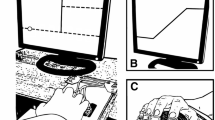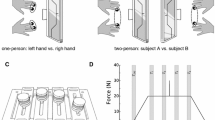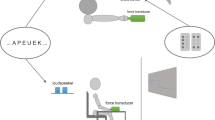Summary
An experiment was performed which examined movement planning and force transition control in six patients with Parkinson's disease (PD) during a sequence of five finger taps at either a fast (200 ms) or slow (600 ms) temporal speed. The patients acted as their own controls and performed finger taps under three task conditions: (1) where all taps had to be of the same force intensity: no stress; (2) where it was known that one of the taps had to be executed with an augmented force: stress simple reaction time (SRT); and (3) where it was not known prior to initiation which one of the taps was to be more forcefully produced: stress choice reaction time (CRT). Reaction time data revealed a between-condition effect where stress SRT was faster than stress CRT and no stress was faster than both. Under both speed conditions, the interval after the stressed tap was profoundly lengthened. It was found that the lengthening was due to increases in both lift and dwell times for the slow tapping rate. In contrast, at the fast tapping rate, proportionately more of the interval increase was due to the increase in lift time. These findings suggest that patients with Parkinsons disease, when performing under a motor program mode, have difficulty in initiating a sequence and making a transition to lighter force levels after a stressed tap.
Similar content being viewed by others
References
Bloxham CA, Mindel TA, Frith CD (1984) Initiation and execution of predictable and unpredictable movements in Parkinson's disease. Brain 107:371–384
Day BL, Dick JPR, Marsden CD (1984) Patients with Parkinson's disease can employ a predictive motor strategy. J Neurol Neurosurg Psychiatry 47:1299–1306
Evarts E, Teravainen H, Calne DB (1981) Reaction time in Parkinson's disease. Brain 104:167–186
Flowers K (1978) Some frequency response characteristics of Parkinsonism on pursuit tracking. Brain 101:19–34
Hefter H, Wing A, Freund HJ. Deficits in producing rapid force increases and decreases in Parkinson's desease. 9th Int Symp on Parkinson's Disease. Jerusalem, Israel, June 5–9, 1988
Marsden CD (1982) The mysterious motor function of the basal ganglia: The Robert Wartenberg lecture. J Neurol 32:514–539
Semjen A, Garcia-Colera A (1986) Planning and timing of finger tapping sequences with a stressed element. J Motor Behav 18:279–287
Stelmach GE, Worringham CJ (1988) The preparation and production of isometric force in Parkinson's disease. Neuropsychologia 26:93–103
Stelmach GE, Worringham CJ (1988) The control of bimanual aiming movements in Parkinson's disease. J Neurol Neurosurg Psychiatry 51:223–231
Stelmach GE, Worringham Cj, Strand EA (1986) Movement preparation in Parkinson's disease: The use of advance information. Brain 109:1179–1194
Teasdale N, Stelmach GE, Phillips J (1989) Underlying deficits in the temporal movement control of patients with Parkinson's disease. J Neurol Neurosurg Psychiatry (in press)
Wing Am (1988) A comparison of the rate of pinch grip force increases and decreases in Parkinsonian bradykinesia. Neuropsychologia 26:479–482
Worringham CJ, Stelmach GE (1989) Practice effects on the preprogramming of discrete movements in Parkinson's disease. J Neurol Neurosurg Psychiatry (submitted)
Author information
Authors and Affiliations
Additional information
This research was supported by the National Institute of Neurological Diseases and Stroke, grant no. NS17421
Rights and permissions
About this article
Cite this article
Stelmach, G.E., Garcia-Colera, A. & Martin, Z.E. Force transition control within a movement sequence in parkinson's disease. J Neurol 236, 406–410 (1989). https://doi.org/10.1007/BF00314899
Received:
Revised:
Accepted:
Issue Date:
DOI: https://doi.org/10.1007/BF00314899




